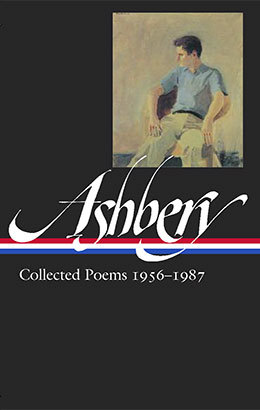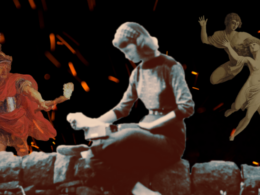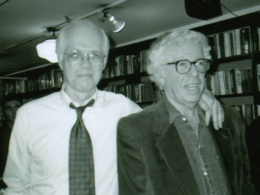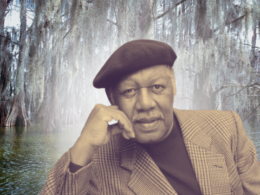In connection with the publication in October 2008 of John Ashbery: Collected Poems 1956–1987, edited by Mark Ford, Rich Kelley conducted this exclusive interview for the Library of America e-Newsletter.
LOA: Collected Poems features the first twelve books of poetry you published between 1956 and 1987 and 65 uncollected poems you wrote between 1945 and 1990. The volume spans 1,042 pages and includes more than 450 poems, a monumental amount of work. In preparing the work for publication, what kind of thoughts and feelings did you have as you revisited your poems?
Ashbery: It was like having a conversation with yourself, except you can’t see yourself. Je est un autre, as Rimbaud famously said. (Actually I hate that formula—he didn’t famously say it, he said it and it became famous.) Sort of like talking to a priest in a confessional box, I imagine, though I’m not a Catholic and have never done so. Or maybe it was like being in the confessional and hearing my own confession.
To tell the truth, though, I really wasn’t very preoccupied with “thoughts and feelings” when I revisited my early work. First of all, the selections were mostly made long ago, when I put together the original volumes. There was a certain amount of checking them to see if they still seemed to hold up, that they looked presentable. Then there was the question of the previously uncollected poems, which I had left out presumably because I hadn’t felt confident of them. Or because they somehow didn’t fit the shape of a particular book, or seemed repetitive of other poems in it. How were they now? Some were OK, some not so OK. I had to decide which of those in the latter group were of sufficient “historical” interest to warrant inclusion for the benefit of someone who might be studying my work. Those that made the cut are in. There are of course poems still absent from this collection which maybe someday someone with patience will excavate.
LOA: How do you think your work has changed during this period? Do you hear one voice or many?
Ashbery: This is an interesting question, which I’ve been asked before and can never come up with a truly satisfying reply to. First of all, what is “my” voice? I hear it sometimes, but it’s always hard to know where it’s coming from and at whom it’s directed, as I just mentioned. Sometimes I feel caught in the middle, as though I’d just interrupted a dialogue. Then, still not being able to define this voice, how do I think it’s changed over the years? There is something constant, I feel, but I’m hard put to say what it is. Some early poems sound as though I wrote them recently, except for a kind of depth or background that they lack. But certainly some ancient lines are ones I could have written today, like the last line of my 1953 poem “Popular Songs”: “The actors prepare their first decline.” I love that line and I still like the poem a lot. All it needed was a few decades of transparent overlay.
LOA: Do you have any favorites among the poems collected here?
Ashbery: Where to begin? (Joke.) I think I’ll just mention a few little-known ones (at least I think they are) I happen to be fond of: “He,” “Idaho,” “Eclogue,” “Rain,” “The Chateau Hardware,” “Description of a Masque,” “Alone in the Lumber Business.” Of the hitherto uncollected ones I especially now like “The Young Prince and the Young Princess,” which I removed from The Tennis Court Oath for reasons I can’t remember.
LOA: What may interest readers of your work most about this volume are the 65 poems that have appeared in periodicals, anthologies, or limited editions, but have not been previously collected. Would you like to single out any of them with a comment on why you’re deciding to collect them now?
Ashbery: Actually I just did that. I think I’d rather not try to formulate my reasons for omitting those poems, as it will leave the poor things on the defensive, exposed to harsh blasts of criticism.
LOA: A book this rich with your poems offers a reader an unusual opportunity. She could, of course, simply read it from start to finish, chronologically, reaching your uncollected work at the end. I wonder if you might be willing to suggest alternative paths. For instance, if someone wanted to read poems that reflected the “antic John Ashbery,” or the “amorous John Ashbery,” the “solemn John Ashbery,” or “the French John Ashbery,” which poems should she read?
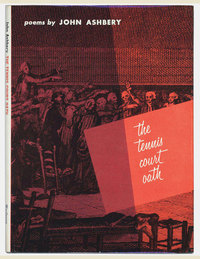
Ashbery: It’s hard for me to determine which poems would fall under which heading, though the French JA would probably be somehow reflected in the two collections I wrote mostly while I was living in France, The Tennis Court Oath and Rivers and Mountains. Together these two also represent for me a kind of turning point in my writing. TCO was written mainly during a frustrating period when I was trying to move beyond what were to me the successful poems in Some Trees toward something else—but what? The fact that I was living in France and hence deprived of hearing American speech around me aggravated the situation. (American vernacular is an important stimulus for me.) I then began doing my own kind of “cut-ups” (Burroughs and Ginsberg were simultaneously experimenting with them in Paris, but I didn’t know that), that is, collage elements from magazines or popular literature (including a circa World War I British novel for girls called Beryl of the Biplane that I found at a bookstall along the Seine).
I thought of this, insofar as I formulated it at all, as a temporary phase of troubling the waters so as to be able to fish in them later. Many would agree that I succeeded all too well at the first stage of this enterprise. I intended to put everything back together again later so it would be “the same only different.” And actually I accomplished this, to my own satisfaction at least. The poem that seemed to embody the change for me was “Rivers and Mountains.” Shortly after that I wrote “Clepsydra,” which seemed to kind of anchor this new way of writing. As for the antic, amorous, solemn JA’s, I’d like to think they all exist simultaneously in all my poems, along with a lot of other me’s. I believe that one should try to get as many different kinds of stuff into one’s writing as possible.
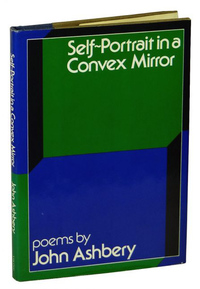
LOA: In 1975, Self-Portrait in a Convex Mirror won the poetry triple crown: the Pulitzer Prize, the National Book Award, and the National Book Critics Circle Award. The title poem is perhaps your most celebrated work and yet you have said you’ve “never really cared for ‘Self-Portrait’ very much.” How would you describe the difference between the poems of yours that critics applaud and the ones that you like best?
Ashbery: I don’t remember where I said I didn’t care for it very much, though I probably did. Let’s see. I usually write quickly and don’t revise a lot, but this poem took months to write and required seemingly endless revisions—should I have taken the hint of its success and applied myself more to my other poems? Whatever, I hate work and yet love the feeling of having accomplished something, so this effort probably rubbed me the wrong way. I felt I was weakening it each time I set out to revise it, which is how I felt when I was young and labored over my poems till they “smelled of the lamp.” Also, the mock art-historical essay form I used began to get on my nerves after a while, though this may be precisely what draws readers to it—they think they see a plan, whereas it’s really just as scattershot and disorganized as my other writing. Maybe the fact that I had myself been writing art criticism at that time for fifteen years also created this feeling of trust in readers and suspicion in myself. I always kept these two kinds of writing separate in my mind: my poems “spontaneous and unrehearsed”; my critical articles clear and usually intended for a general readership—that of the Paris Herald Tribune, New York magazine, and Newsweek— and therefore, I hoped, clear and uncomplicated. Mary McCarthy, whom I knew in Paris, once complimented me on my reviews in the Tribune, and was about to add “but why can’t you write poetry like that,” before she stopped herself.
Where was I? Anyway, I had been “carrying around” with me the image of the Parmigianino painting of the same name for years, with a vague intention of “doing something” with it, after first seeing a reproduction of it in about 1950 and eventually the original in Vienna in 1959—it is truly a miraculous painting. Finally, during a period of leisure at the Fine Arts Work Center in Provincetown in 1973, which coincided with a time when I wasn’t writing art criticism and therefore perhaps felt I had been given permission to write poetry about a painting, I began tentatively to work on it. It took me four or five months and many picky corrections, to the point where I was sick of looking at it. I was, obviously, totally surprised when the book was published and it won all those prizes. Perhaps I was a bit jealous that the book got the attention that I thought belonged to me.
On the other hand, I’m really grateful that critics “applaud” it. There are others of my poems I like better, like “Clepsydra”—but hey, de gustibus, right?
LOA: You’ve made it clear in several statements that there never was a so-called “New York School of Poets” in the 1950s and that this was a name thrust on you, Frank O’Hara, Kenneth Koch, James Schuyler, Barbara Guest, Kenward Elmslie, and others because you all lived in New York and were friends with the painters in the New York School of Painting. On the other hand, David Lehman has written that “the term is not without its virtues, not least because, without thinking of themselves as parts of a collective, these writers demonstrated a unique capacity for sympathetic identification with one another.” Do you find that to be a fair characterization and do you think this “sympathetic identification” has had any effect on your poetry?
Ashbery: We all need labels for construing things, and the New York School is a fairly innocuous one. It was coined by the art dealer John Myers, who published our early work in pamphlet format at the Tibor de Nagy Gallery, and he thought that some of the luster of the New York School painters (Pollock, de Kooning, et al.) would rub off on his little band of unknown poets. I had no problem with that. The thing is, though, that while we were friends, we had no platform or program the way the Surrealists and later the Black Mountain and Language poets did. We were just friends who had somewhat similar tastes in art and poetry. We all had a kind of urge to experiment, though it emerged in different ways. Frank used it to explore the many passionate relationships, sexual and other, that he was always plunging into. Kenneth was simply in love with poetry, classical as well as modern, and wrote mock heroic epics in the style of Byron and James Thomson as well as Dadaist dream factory poems. Jimmy Schuyler was a kind of botanizing parson who loved the diaries of Francis Kilvert, for instance, yet he too was incorrigibly, sensationally modern. Barbara wrote about love and objects in the same rapt, engaging tone. Kenward is the foxy Grandpa of the New York School—given to demotic American crankiness and Burroughsian post-apocalyptic divertissements. So yeah, this sympathetic if synthetic identification thrust us all together for better or worse, mostly the former, I think.
LOA: According to the book’s chronology, you decided to become a Surrealist painter at the age of nine. The New York Times recently profiled you in connection with the current show of your collages at the Tibor de Nagy Gallery in New York. Several of your poems—“Europe,” “America,” “Idaho”— have been described as collages, and the juxtaposition en face of your text and Joe Brainard’s black-and-white drawings in The Vermont Notebook makes it as much an art book as a work of poetry. Do you see similarities in how you write poems and how you create collages?
Ashbery: In one of the early issues of Life, in December 1936, there was an article about a show called Fantastic Art, Dada, and Surrealism, organized by Alfred Barr at the Museum of Modern Art. There were reproductions of work by Dali (his notorious Persistence of Memory, with its drooping watches), Magritte, Ernst (I think), Victor Brauner, and Meret Oppenheim’s fur-lined teacup. I was nine at the time and had never seen anything like that. I don’t know if I decided on the spot to become a Surrealist painter, but it certainly had an impact on me.
I always drew and painted as a child, and soon began attending art classes for children at the Memorial Art Gallery in Rochester. Later I spent two years at Deerfield Academy, where there was an art studio and a resident artist of some note, Donald Greason. He gave me to understand that it was all well and good to be a Surrealist, but first I would have to learn to paint “things as they are,” still-lifes or in one case a self-portrait, from a model. I got kind of interested in being an academic painter, but I stopped painting after I graduated. There was no space to paint at Harvard, besides which I was writing poetry, which interested me more. William Carlos Williams, who also painted when he was young, once said he found it easier to carry a sheaf of poems around than a wet canvas.
At some point in my senior year I began making collages. I’m not sure what started me on this, though it could have been another show at MoMA of surreal collages in the fall of 1948, which I only recently read about. I didn’t see it but would have been aware of it, as I sometimes went to New York to see shows at MoMA. Most of my early ones are lost, but a couple were in my recent show at Tibor de Nagy. I occasionally made collages from postcards in the 1970s, and then did a lot more of them this year for the show.
Collage-making using words seemed to come naturally to me, as I mentioned before about my experiments in Paris. It seems a prototypically modernist strategy—placing something next to something else to see what unexpected result might emerge—as in Lautréamont’s oft-quoted “chance encounter of a sewing machine and an umbrella on a dissecting table.” (I hope I’m getting that right.)
LOA: Music is clearly very important to you. The book’s chronology notes that you resumed writing poetry in 1952 after listening to a John Cage piece at a concert. The two-column format of “Litany” was reportedly inspired by Eliott Carter’s Duo for Violin and Piano—and you’ve actually performed “Litany” with Ann Lauterbach. You’ve said that you had to write “The Songs We Know Best” in order to exorcise from your mind the R&B earworm “Reunited” by Peaches & Herb. Do the music-inspired poems have distinctive leitmotifs running through them? Do they sound different? Are there other examples of music-inspired poems?
Ashbery: As I’ve often said, I envy music’s ability to argue without resorting to words. Recently I heard a TV commercial for one of those “easy listening” classical music CDs that featured the famous variation (no. 18, I think) from Rachmaninoff’s Rhapsody on a Theme of Paganini, one of the most outrageously gorgeous swatches of music ever penned. As I followed it, maybe for the four–hundredth time, each phrase seemed almost on the point of crystallizing into words: first a simple statement, then a reason for not taking this statement too seriously, then a refutation of that objection, and so on, until it finally expires in an almost orgasmic message of hope tempered by experience. Or something. One felt the meaning so much more acutely than if it had been nailed down with words, even those of a great poet. I envy that means of expression.
I would say that there are examples of music-inspired poetry—or music emulating poetry—throughout my work. They don’t necessarily “sound” musical; in fact I’m not interested in “euphony” (of the Tennysonian type for instance, much as I love Tennyson)—but they are musical in their way of demonstrating, developing, and resolving. That early poem “Popular Songs” would be an example. “Litany” may have been inspired—I’m never too sure of these things—by hearing Carter’s Duo performed by a violinist and pianist who were situated far apart from each other on the stage at Cooper Union. They could almost have been in different worlds, except for the fact that they were obviously listening to and spying on each other, each trying to get the upper hand. It was quite striking when the modest-toned violin sometimes won out over the piano. As for “The Songs We Know Best,” that was purely and simply an exercise in exorcism. The “Reunited” tune got stuck in my head while I was listening to a taxi radio and wouldn’t go away until I wrote about it. I’m grateful to the cab driver since I like the poem.
LOA: As someone who has also spent decades writing criticism, you have mastered the craft of introducing readers to artists they might otherwise never encounter and of helping readers understand what makes an artist distinctive. Does how you approach writing criticism differ from how you write poetry?
Ashbery: It’s funny, I never intended to write criticism, and almost accidentally began writing art reviews to make some extra cash while taking graduate courses at NYU. I used to argue about it with Frank O’Hara, who felt that poets had a duty to write criticism. I strongly disagreed, first because I didn’t think I had the right to judge other people’s work, and second because I thought it wasn’t congenial to the practice of writing poetry. The result has been that I have ended up producing a body of critical writing that dwarfs my written poetry—in size, that is. Having once begun, I couldn’t stop!
I’ve justified this by pretending that while my criticism may not be all that great, it’s probably as good as anybody else’s. Also much of it was written for a general audience and it’s refreshing to write for, and not down to, such an audience—an experience different from writing poetry, which one expects will gravitate to the smaller, clued-in public for poetry. It’s a good exercise in keeping things simple. Well, you say, but your poetry is hardly simple. To which I reply that it’s simpler than it would have been if I hadn’t simplified it. Boris Pasternak quoted the composer Scriabin, known for his fantastically complex music, as saying “Simplify! Simplify!” Or was it Henry James who said that? The point is that the subject matter of poetry and art is incredibly complicated, and one’s best efforts at plain speaking will usually not result in something that sounds like plain speech.
Another unlikely fringe benefit of being an arts journalist was living with deadlines. I am a terrible procrastinator and having to face twice-weekly deadlines (as I did during my five years in Paris as art critic for the European edition of The New York Herald Tribune) shook me up a lot and eventually affected my laziness about writing poetry, for instance. It occurred to me at some point that if I could cope with publishers’ time limits, I could set some for myself. This has made me more productive. When I was young I used to lie around waiting for inspiration. In later life I’ve realized that one can usually get along without it. Also, it’s been rewarding to be able to direct readers toward material they might not encounter otherwise. That’s why so many of my critical pieces deal with lesser-known artists and writers. In many cases I’ve felt a mission to bring their work to public notice. I suppose in a way it’s gratitude for having myself benefited from so much critical attention, much of it favorable. The Library of America volume is the latest example of this.
Copyright © 2008 John Ashbery.
